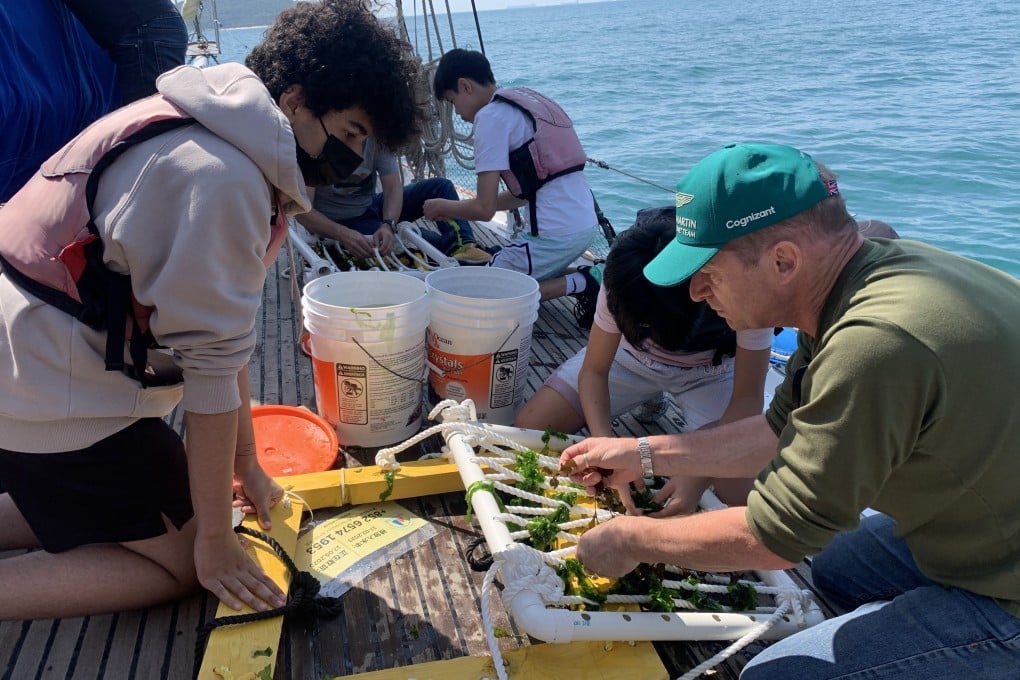




Seaweed is good for you, but it can also help to improve water quality!

Seaweed is good for you, but it can also help to improve water quality!

For the past year, Jeremy Yang and his friends at the Harbour School have been working on one of Hong Kong's most unique school projects: building seaweed farms along the city's coast.
"My role in the seaweed farming project was to plan and design the entire farm," he explains.
Students and staff from the school in Ap Lei Chau have helped to set up 10 seaweed farms across Hong Kong. Each floating farm measures about one cubic metre.
"Seaweed filters the water, so it improves water quality. It acts as a habitat for a lot of marine animals. It produces oxygen and absorbs carbon dioxide from the atmosphere," says Handrich Hernando, who works at the school.
Seaweed is special
Seaweed growing has long been practised in many Asian countries, where the plant is used for food. China's Fujian and Shandong provinces, for example, have many seaweed farms.
"However, in Hong Kong, seaweed farming is not very common," Handrich says.
The seaweed farming project was inspired by a film called 2040, which explored solutions to climate change. Jadis Blurton, the head teacher, was amazed by the film. It said seaweed has the potential to combat climate change.
"I did not know all that stuff about seaweed," she says.
Scientists think that more than half of the world's oxygen comes from sea life, such as phytoplankton and seaweed.
They are studying how seaweed farms can be used to store carbon dioxide, as this method may help us reduce the greenhouse gases that are warming our planet.
Love for the ocean
To kick off their seaweed project, the school reached out to experts.
Carlos Rius is the school's marine scientist and so he led their study on seaweed farming. He helped the students to find the best places where the seaweed farms would not disturb other species.
Johnson Stanley, the captain of the school's sailing boat, explained how they chose where to put the seaweed farms.
"We chose places where we had seen some seaweed species growing, sheltered from the wind," he says, "and also where we could put the structures safely without causing any danger to ships."
They planted two types of seaweed that grow in Hong Kong's waters: Ulva, a green seaweed, and Sargassum, a brown seaweed.
Students learned about seaweed at the Marine Science Centre, and some of them did aquarium experiments. Older students researched things that can be made from seaweed, such as bioplastics.
"Hopefully, more people are realising the benefits of seaweed," Jadis says.
She is proud of how pupils have taken part. "We hope that students can take away a real love for the ocean and a feeling that they can do something to make a change."
Fun facts
Seaweed is rich in calcium, iodine and magnesium. Like plants on land, seaweeds need sunlight. Some seaweeds like to grow on rocks in the sea, while others just float around!
Quick questions
- What happens with seaweed and carbon dioxide?
- Does seaweed grow naturally in Hong Kong's waters?
- What is the tastiest way to use seaweed for food?

a plant that grows in the sea, or on rocks at the edge of the sea. There are many different types of seaweed, some of which are eaten as food
the standard of something when it is compared to other things like it; how good or bad something is
filter something to pass liquid, light, etc. through a special device, especially to remove something that is not wanted
connected with the sea and the creatures and plants that live there